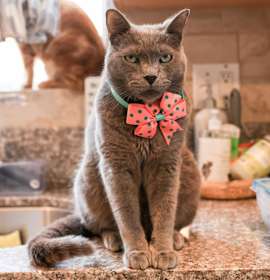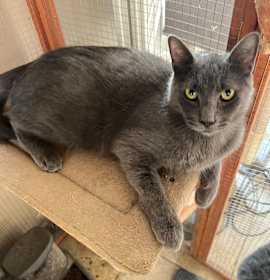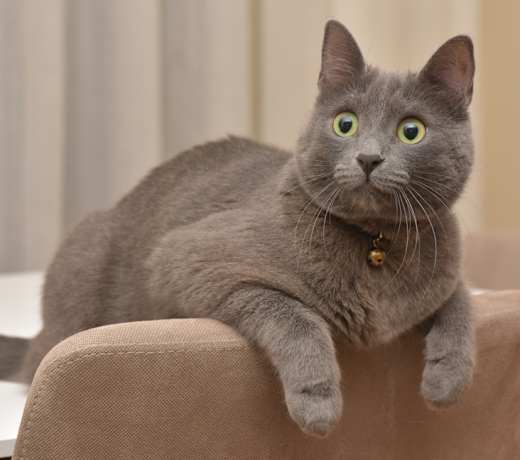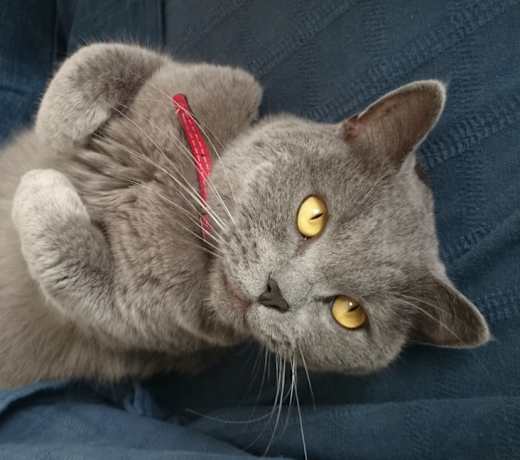The easiest way to adopt a Russian Blue would be through a rescue that specializes in Russian Blues. A great place to start would be by starting a breed search on Adopt a Pet. The search will show you all the available Russian Blues in your area.
Adopt A Russian Blue
20 available Russian Blues near you
Sort by:
Any
Any
Any

Baby Blue Contact-Sylva
Russian Blue
Male, 8 mos
Studio City, CA
Color
Gray or Blue
Size
(when grown) -
Details
Good with dogs
Good with cats
Spayed or Neutered
Shots are up-to-date
Good with cats
Spayed or Neutered
Shots are up-to-date
Story

Link
Russian Blue
Male, 6 yrs 9 mos
Los Angeles, CA
Color
Gray or Blue
Size
(when grown) -
Details
Spayed or Neutered
Story

Leona
Russian Blue Domestic Shorthair
Female, 9 mos
Los Angeles, CA
Color
Gray or Blue
Size
(when grown) -
Details
Good with kids
Good with dogs
Good with cats
Spayed or Neutered
Good with dogs
Good with cats
Spayed or Neutered
Story

Nubbins
Russian Blue Domestic Shorthair
Male, 6 yrs 10 mos
Los Angeles, CA
Color
Gray or Blue
Size
(when grown) -
Details
Spayed or Neutered
Story

Corvette
Russian Blue Domestic Shorthair
Male, 7 yrs 7 mos
Los Angeles, CA
Color
Gray or Blue
Size
(when grown) -
Details
Good with kids
Good with dogs
Good with cats
Needs special attention
Spayed or Neutered
Good with dogs
Good with cats
Needs special attention
Spayed or Neutered
Story


Squid
Russian Blue
Male, 2 mos
Los Angeles, CA
Color
Gray or Blue
Size
(when grown) -
Details
Good with cats
Spayed or Neutered
Spayed or Neutered
Story

Barbie!!!
Russian Blue
Female, 4 mos
Los Angeles, CA
Color
Gray or Blue
Size
(when grown) -
Details
Good with kids
Good with dogs
Good with cats
Spayed or Neutered
Shots are up-to-date
Good with dogs
Good with cats
Spayed or Neutered
Shots are up-to-date
Story

Archie
Russian Blue
Male, 1 yr 10 mos
Canoga Park, CA
Color
Gray or Blue
Size
(when grown) -
Details
Good with kids
Good with cats
Spayed or Neutered
Shots are up-to-date
Good with cats
Spayed or Neutered
Shots are up-to-date
Story

Brandie
Russian Blue
Female, young
Chatsworth, CA
Color
Gray or Blue (Mostly)
Size
(when grown) -
Details
Spayed or Neutered
Story

Rocket
Russian Blue
Male, 1 yr 9 mos
Pasadena, CA
Color
Gray or Blue
Size
(when grown) -
Details
Good with cats
Needs special attention
Spayed or Neutered
Shots are up-to-date
Needs special attention
Spayed or Neutered
Shots are up-to-date
Story

Handsome BP Boy
Russian Blue
Male, young
San Gabriel, CA
Color
Gray or Blue
Size
(when grown) -
Details
Good with kids
Good with cats
House-trained
Spayed or Neutered
Shots are up-to-date
Good with cats
House-trained
Spayed or Neutered
Shots are up-to-date
Story

Portia LA
Russian Blue
Female, young
San Gabriel, CA
Color
Gray or Blue
Size
(when grown) -
Details
Good with kids
Good with cats
Needs experienced adopter
House-trained
Spayed or Neutered
Shots are up-to-date
Good with cats
Needs experienced adopter
House-trained
Spayed or Neutered
Shots are up-to-date
Story
1 - 9 of 20 pets available
Search for Russian Blue kittens and cats
Find adoptable Russian Blue by Beverly Hills, CA
Russian Blue kittens near meRussian Blue in Agoura Hills, CARussian Blue in Alhambra, CARussian Blue in Anaheim, CARussian Blue in Arcadia, CARussian Blue in Artesia, CARussian Blue in Azusa, CARussian Blue in Baldwin Park, CARussian Blue in Bell, CARussian Blue in Bellflower, CARussian Blue in Bell Gardens, CARussian Blue in Brea, CARussian Blue in Buena Park, CARussian Blue in Burbank, CARussian Blue in Calabasas, CARussian Blue in Camarillo, CARussian Blue in Carson, CARussian Blue in Cerritos, CARussian Blue in Commerce, CARussian Blue in Compton, CARussian Blue in Covina, CARussian Blue in Cudahy, CARussian Blue in Culver City, CARussian Blue in Cypress, CARussian Blue in Diamond Bar, CARussian Blue in Downey, CARussian Blue in Duarte, CARussian Blue in El Monte, CARussian Blue in El Segundo, CARussian Blue in Fullerton, CARussian Blue in Gardena, CARussian Blue in Garden Grove, CARussian Blue in Glendale, CARussian Blue in Glendora, CARussian Blue in Hawaiian Gardens, CARussian Blue in Hawthorne, CARussian Blue in Hermosa Beach, CARussian Blue in Huntington Beach, CARussian Blue in Huntington Park, CARussian Blue in Inglewood, CARussian Blue in La Canada Flintridge, CARussian Blue in La Habra, CARussian Blue in La Habra Heights, CARussian Blue in Lakewood, CARussian Blue in La Mirada, CARussian Blue in La Palma, CARussian Blue in La Puente, CARussian Blue in Lawndale, CARussian Blue in Lomita, CARussian Blue in Long Beach, CARussian Blue in Los Alamitos, CARussian Blue in Los Angeles, CARussian Blue in Lynwood, CARussian Blue in Malibu, CARussian Blue in Manhattan Beach, CARussian Blue in Maywood, CARussian Blue in Monrovia, CARussian Blue in Montebello, CARussian Blue in Monterey Park, CARussian Blue in Moorpark, CARussian Blue in Norwalk, CARussian Blue in Palos Verdes Estates, CARussian Blue in Paramount, CARussian Blue in Pasadena, CARussian Blue in Pico Rivera, CARussian Blue in Pomona, CARussian Blue in Rancho Palos Verdes, CARussian Blue in Redondo Beach, CARussian Blue in Rolling Hills Estates, CARussian Blue in Rosemead, CARussian Blue in San Dimas, CARussian Blue in San Fernando, CARussian Blue in San Gabriel, CARussian Blue in San Marino, CARussian Blue in Santa Clarita, CARussian Blue in Santa Fe Springs, CARussian Blue in Santa Monica, CARussian Blue in Seal Beach, CARussian Blue in Sierra Madre, CARussian Blue in Signal Hill, CARussian Blue in Simi Valley, CARussian Blue in South El Monte, CARussian Blue in South Gate, CARussian Blue in South Pasadena, CARussian Blue in Stanton, CARussian Blue in Temple City, CARussian Blue in Thousand Oaks, CARussian Blue in Torrance, CARussian Blue in Walnut, CARussian Blue in West Covina, CARussian Blue in West Hollywood, CARussian Blue in Westlake Village, CARussian Blue in Westminster, CARussian Blue in Whittier, CA
Animal shelters near Beverly Hills, CA
Cat shelters near meCat shelters in Agoura HillsCat shelters in AlhambraCat shelters in AnaheimCat shelters in ArcadiaCat shelters in ArtesiaCat shelters in AzusaCat shelters in Baldwin ParkCat shelters in BellCat shelters in BellflowerCat shelters in Bell GardensCat shelters in BreaCat shelters in Buena ParkCat shelters in BurbankCat shelters in CalabasasCat shelters in CamarilloCat shelters in CarsonCat shelters in CerritosCat shelters in CommerceCat shelters in ComptonCat shelters in CovinaCat shelters in CudahyCat shelters in Culver CityCat shelters in CypressCat shelters in Diamond BarCat shelters in DowneyCat shelters in DuarteCat shelters in El MonteCat shelters in El SegundoCat shelters in FullertonCat shelters in GardenaCat shelters in Garden GroveCat shelters in GlendaleCat shelters in GlendoraCat shelters in Hawaiian GardensCat shelters in HawthorneCat shelters in Hermosa BeachCat shelters in Huntington BeachCat shelters in Huntington ParkCat shelters in InglewoodCat shelters in La Canada FlintridgeCat shelters in La HabraCat shelters in La Habra HeightsCat shelters in LakewoodCat shelters in La MiradaCat shelters in La PalmaCat shelters in La PuenteCat shelters in LawndaleCat shelters in LomitaCat shelters in Long BeachCat shelters in Los AlamitosCat shelters in Los AngelesCat shelters in LynwoodCat shelters in MalibuCat shelters in Manhattan BeachCat shelters in MaywoodCat shelters in MonroviaCat shelters in MontebelloCat shelters in Monterey ParkCat shelters in MoorparkCat shelters in NorwalkCat shelters in Palos Verdes EstatesCat shelters in ParamountCat shelters in PasadenaCat shelters in Pico RiveraCat shelters in PomonaCat shelters in Rancho Palos VerdesCat shelters in Redondo BeachCat shelters in Rolling Hills EstatesCat shelters in RosemeadCat shelters in San DimasCat shelters in San FernandoCat shelters in San GabrielCat shelters in San MarinoCat shelters in Santa ClaritaCat shelters in Santa Fe SpringsCat shelters in Santa MonicaCat shelters in Seal BeachCat shelters in Sierra MadreCat shelters in Signal HillCat shelters in Simi ValleyCat shelters in South El MonteCat shelters in South GateCat shelters in South PasadenaCat shelters in StantonCat shelters in Temple CityCat shelters in Thousand OaksCat shelters in TorranceCat shelters in WalnutCat shelters in West CovinaCat shelters in West HollywoodCat shelters in Westlake VillageCat shelters in WestminsterCat shelters in Whittier
Adopting a Russian Blue
Frequently asked questions about acquiring an Russian Blue - the pros and cons of adopting versus going through a breeder, and associated costs.




